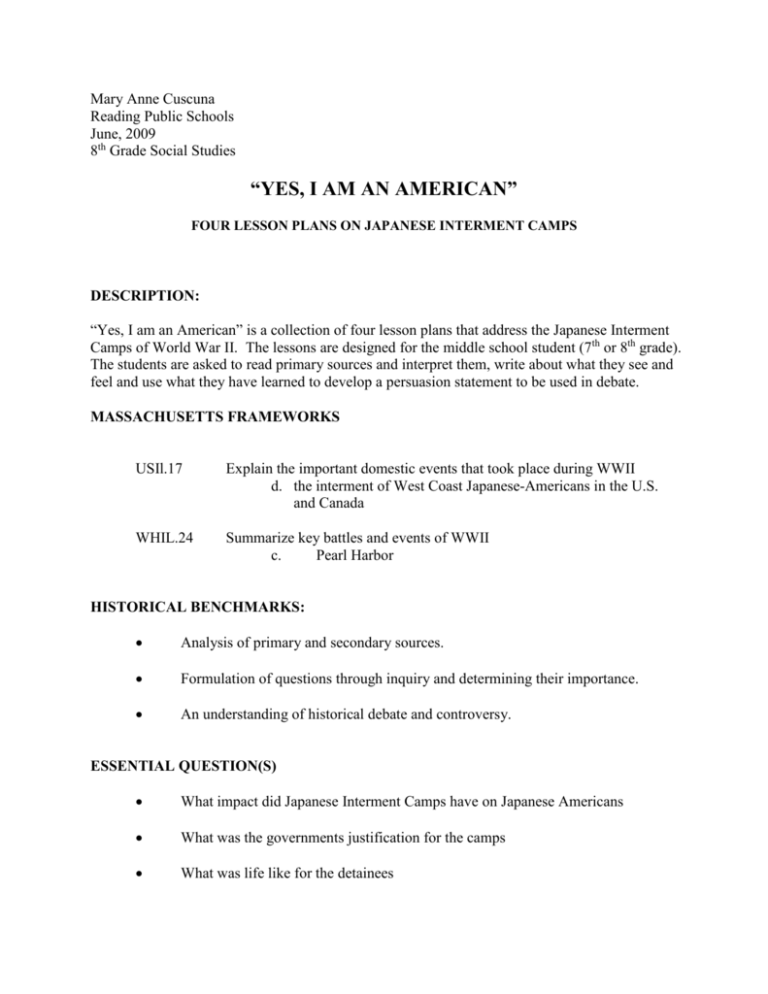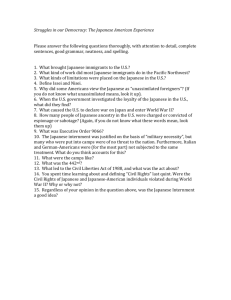Cuscuna book group lesson - The University of Massachusetts
advertisement

Mary Anne Cuscuna Reading Public Schools June, 2009 8th Grade Social Studies “YES, I AM AN AMERICAN” FOUR LESSON PLANS ON JAPANESE INTERMENT CAMPS DESCRIPTION: “Yes, I am an American” is a collection of four lesson plans that address the Japanese Interment Camps of World War II. The lessons are designed for the middle school student (7th or 8th grade). The students are asked to read primary sources and interpret them, write about what they see and feel and use what they have learned to develop a persuasion statement to be used in debate. MASSACHUSETTS FRAMEWORKS USIl.17 Explain the important domestic events that took place during WWII d. the interment of West Coast Japanese-Americans in the U.S. and Canada WHIL.24 Summarize key battles and events of WWII c. Pearl Harbor HISTORICAL BENCHMARKS: Analysis of primary and secondary sources. Formulation of questions through inquiry and determining their importance. An understanding of historical debate and controversy. ESSENTIAL QUESTION(S) What impact did Japanese Interment Camps have on Japanese Americans What was the governments justification for the camps What was life like for the detainees LEARNING OBJECTIVES: Students will be able to... Recognize points of view in print and visual sources Identify and analyze historical images Understand historical debate and controversy Understand the importance of oral history LESSON ONE/ DAY ONE MATERIALS: Travel Trunk Written Document Analysis sheet (Student Handout #1) Copy of Civilian Order No. 5 (Student Handout #2) A brief History of Japanese Interment Camps (Student Handout #3) PROCEDURE 1. As the class begins tell the students that they are leaving their home and the have one day to pack what they feel they may need. If possible show the students a travel trunk in which all their belongings must fit. 2. Discuss with the students what they would bring and why. Make a class list. 3. Give each student a copy of Civilian Order No. 5. Each student should quietly read it. Pass out student handout 1 “Written Document Analysis Sheet” Give the students a few minutes to read the document and fill out the data sheet. 4. Discuss with the students the information that they gathered from reading the document. Focus on the question about what life was like during the time that this document was written. 5. Introduce the Japanese Interment Camps. Students will read the background information for homework. LESSON TWO/ DAY TWO MATERIALS: Student Handout #3 “A Brief History of Japanese Interment Camps” Various photographs of Japanese Interment Camps (from websites) Large chart paper/markers Readings from “Letters to Miss Breed” http://www.janm.org/exhibitions/breed PROCEDURE 1. Review with the students what they read as homework. The following can be used as discussion prompts. o What struck them? o What were some of the reasons for the camps? 2. Divide the class into groups of three. 3. Each group will be given a photograph of the interment camps. 4. Have each group analyze the photo. Instruct the students to write down everything they notice in the photo on the chart paper. 5. Once the students have completed analyzing the photo have a group member report to the class what they observed/noticed about their photograph. 6. Have the students close their eyes and put their heads down on the desk, if possible. Read to the students “Letters to Miss Breed” http://www.janm.org/exhibitions/breed about conditions in the camps. As you are reading ask the students to imagine themselves in this situation. 7. Once you have finished reading students can raise their heads and open their eyes. 8. Ask the students to know write a letter to Miss Breed about their impressions of life in the camps. LESSON THREE/ DAY THREE MATERIALS: Copy of student handout # 5 “Executive Order 9066. PROCEDURE: 1. Handout copies of Executive Order 9066 to the students. 2. Have the students read the handout and highlight any words or phrases that they are “struck” by. Words or phrases that may create emotions in them. 3. Explain to the students that they are now going to take the words that they have highlighted and incorporate them into a poem. 4. The poem that they create can be in any format they wish. Not all the words or phrases that they highlighted have to be used. 5. Once the students have completed their poems ask the students to share. 6. Poems can be edited into final form and illustrated for display. LESSON FOUR/ DAY FOUR MATERIALS: Copies of quote from What Did the Interment of Japanese Americans Mean? (Page 136) PROCEDURE: Students will be given the following quote; “I worship you in spite of the errors you have made. Yes, you have made errors and you have roamed on many wrong roads; but everyone makes mistakes…All I ask is that you do not make the same mistake twice; that is inexcusable even in the eyes of one who loves you so. 1. Ask the students to read the quote quietly to themselves. 2. Discuss with the students the following questions: a. b. c. d. Who do they think wrote this? For whom is it written? Why was it written? What is the tone of the letter? 3. After a brief discussion explain to the students that this was a “Love Letter” written by an evacuee to the United States of America. 4. Explain to the students that they are now going to write a response to this letter. 5. The student’s letter can take any form that they wish but must address the passion that the evacuee feels for the United States. LESSON PLAN(S) ASSESSMENT As an assessment on the lessons, the students will write a persuasion essay. The essay may take the standpoint of being in favor of the camps and that the United States was justified in their actions or that the actions were unjustified. Which ever standpoint the student takes they must support their essay with facts and sources. Once the students have completed their position statements engage the students in a class debate about the actions that the United States took in World War II. Works Cited American Memory from the Library of Congress - Home Page. 07 June 2009 <http://memory.loc.gov/>. This is the Library of Congress website for the American Memory. This website is not only easy to use but is rich with photographs and narration. "Children of Minidoka - Student Essays." University of Washington Libraries. 07 June 2009 <http://www.lib.washington.edu/exhibits/harmony/aas372/essay.html>. This is a great website to use with students. There are essays, drawings, and pictures focusing on the children of Minidoka Interment Camp. This is also a very easy website to navigate Densho: The Japanese American Legacy Project, digital archive of video oral histories of Japanese-Americans incarcerated or interned during World War II. 12 June 2009 <http://www.densho.org>. Oral histories are a great way for students to feel connected to a subject and this website has some great interviews. It also is enhanced with pictures, maps, and artwork that was created in the camps. "Face to Face : Activities." Independent Television Service (ITVS). 06 June 2009 <http://www.itvs.org/facetoface/activities/>. Not only does this website deal with the Japanese Interment issue but it also address the biotry around Sept. 11th and does a great job connecting the two. The oral histories are great for the students to listen to. Home | Japanese American National Museum. 09 June 2009 <http://www.janm.org/exhibitions>. "Japanese Relocation and Internment." National Archives and Records Administration. 02 June 2009 <http://www.archives.gov/research/alic/reference/military/japaneseinternment.html>. This is a great site for not only teachers but students as well. Teachers can gain background information while students can view pictures and read actual letters from the camps. Murray, Alice Y. What Did the Interment of Japanese Americans Mean? New York: Bedford/St. Martin's, 2000. Although not a book that would be given to students to read, certain excerpts are very useful in the classroom. Good descriptions of camp life. Works Cited (continued) "Smithsonian Education - Lesson Plan - Japanese American Internment." Smithsonian Education - Welcome. 06 June 2009 <http://www.smithsonianeducation.org/educators/lesson_plans/japanese_internmen t/lesson1_b.html>. Great place to go to get started when thinking about lessons on Japanese Internment Camps. Links to other websites that are helpful. STUDENT HANDOUT #2 www.english.illinois.edu/.../g_l/haiku/9066.htm STUDENT HANDOUT #1 Written Document Analysis Worksheet 1. TYPE OF DOCUMENT (Check one): ___ Newspaper ___ Letter ___ Patent ___ Memorandum ___ Map ___ Telegram ___ Press release ___ Report ___ Advertisement ___ Congressional record ___ Census report ___ Other 2. UNIQUE PHYSICAL QUALITIES OF THE DOCUMENT (Check one or more): ___ Interesting letterhead ___ Handwritten ___ Typed ___ Seals ___ Notations ___ "RECEIVED" stamp ___ Other 3. DATE(S) OF DOCUMENT: _________________________________________ 4. AUTHOR (OR CREATOR) OF THE DOCUMENT: _______________________ POSITION (TITLE): _____________________________________________ 5. FOR WHAT AUDIENCE WAS THE DOCUMENT WRITTEN? ______________ _______________________________________________________________ 6. DOCUMENT INFORMATION (There are many possible ways to answer A-E.) A. List three things the author said that you think are important: 1. ______________________________________________________________ 2. ______________________________________________________________ 3. ______________________________________________________________ B. Why do you think this document was written? ___________________________________________________________________ ___________________________________________________________________ C. What evidence in the document helps you know why it was written? Quote from the document. ___________________________________________________________________ ___________________________________________________________________ STUDENT HANDOUT #1 Written Document Analysis Worksheet D. List two things the document tells you about life in the United States at the time it was written: ____________________________________________________________________ ____________________________________________________________________ E. Write a question to the author that is left unanswered by the document: ____________________________________________________________________ ____________________________________________________________________ Designed and developed by the Education Staff, National Archives and Records Administration, Washington, DC 20408. STUDENT HANDOUT #3 BRIEF HISTORY OF JAPANESE INTERMENT CAMPS IN THE UNTIED STATES Following the Japanese attack on Pearl Harbor on December 7, 1941, President Franklin D. Roosevelt issued Executive Order 9066, which permitted the military to circumvent the constitutional safeguards of American citizens in the name of national defense. The order set into motion the exclusion from certain areas, and the evacuation and mass incarceration of 120,000 persons of Japanese ancestry living on the West Coast, most of whom were U.S. citizens or legal permanent resident aliens. These Japanese Americans, half of whom were children, were incarcerated for up to 4 years, without due process of law or any factual basis, in bleak, remote camps surrounded by barbed wire and armed guards. They were forced to evacuate their homes and leave their jobs; in some cases family members were separated and put into different camps. President Roosevelt himself called the 10 facilities "concentration camps." Some Japanese Americans died in the camps due to inadequate medical care and the emotional stresses they encountered. Several were killed by military guards posted for allegedly resisting orders. At the time, Executive Order 9066 was justified as a "military necessity" to protect against domestic espionage and sabotage. However, it was later documented that "our government had in its possession proof that not one Japanese American, citizen or not, had engaged in espionage, not one had committed any act of sabotage." (Michi Weglyn, 1976). Rather, the causes for this unprecedented action in American history, according to the Commission on Wartime Relocation and Internment of Civilians, "were motivated largely by racial prejudice, wartime hysteria, and a failure of political leadership." Almost 50 years later, through the efforts of leaders and advocates of the Japanese American community, Congress passed the Civil Liberties Act of 1988. Popularly known as the Japanese American Redress Bill, this act acknowledged that "a grave injustice was done" and mandated Congress to pay each victim of internment $20,000 in reparations. The reparations were sent with a signed apology from the President of the United States on behalf of the American people. The period for reparations ended in August of 1998. Despite this redress, the mental and physical health impacts of the trauma of the internment experience continue to affect tens of thousands of Japanese Americans. Health studies have shown a 2 times greater incidence of heart disease and premature death among former internees, compared to noninterned Japanese Americans. http://www.pbs.org/childofcamp/history/index.html STUDENT HANDOUT # 5 Executive Order No. 9066 The President Executive Order Authorizing the Secretary of War to Prescribe Military Areas Whereas the successful prosecution of the war requires every possible protection against espionage and against sabotage to national-defense material, national-defense premises, and national-defense utilities as defined in Section 4, Act of April 20, 1918, 40 Stat. 533, as amended by the Act of November 30, 1940, 54 Stat. 1220, and the Act of August 21, 1941, 55 Stat. 655 (U.S.C., Title 50, Sec. 104); Now, therefore, by virtue of the authority vested in me as President of the United States, and Commander in Chief of the Army and Navy, I hereby authorize and direct the Secretary of War, and the Military Commanders whom he may from time to time designate, whenever he or any designated Commander deems such action necessary or desirable, to prescribe military areas in such places and of such extent as he or the appropriate Military Commander may determine, from which any or all persons may be excluded, and with respect to which, the right of any person to enter, remain in, or leave shall be subject to whatever restrictions the Secretary of War or the appropriate Military Commander may impose in his discretion. The Secretary of War is hereby authorized to provide for residents of any such area who are excluded therefrom, such transportation, food, shelter, and other accommodations as may be necessary, in the judgment of the Secretary of War or the said Military Commander, and until other arrangements are made, to accomplish the purpose of this order. The designation of military areas in any region or locality shall supersede designations of prohibited and restricted areas by the Attorney General under the Proclamations of December 7 and 8, 1941, and shall supersede the responsibility and authority of the Attorney General under the said Proclamations in respect of such prohibited and restricted areas. I hereby further authorize and direct the Secretary of War and the said Military Commanders to take such other steps as he or the appropriate Military Commander may deem advisable to enforce compliance with the restrictions applicable to each Military area hereinabove authorized to be designated, including the use of Federal troops and other Federal Agencies, with authority to accept assistance of state and local agencies. I hereby further authorize and direct all Executive Departments, independent establishments and other Federal Agencies, to assist the Secretary of War or the said Military Commanders in carrying out this Executive Order, including the furnishing of medical aid, hospitalization, food, clothing, transportation, use of land, shelter, and other supplies, equipment, utilities, facilities, and services. This order shall not be construed as modifying or limiting in any way the authority heretofore granted under Executive Order No. 8972, dated December 12, 1941, nor shall it be construed as limiting or modifying the duty and responsibility of the Federal Bureau of Investigation, with respect to the investigation of alleged acts of sabotage or the duty and responsibility of the Attorney General and the Department of Justice under the Proclamations of December 7 and 8, 1941, prescribing regulations for the conduct and control of alien enemies, except as such duty and responsibility is superseded by the designation of military areas hereunder. Franklin D. Roosevelt The White House, February 19, 1942. [F.R. Doc. 42–1563; Filed, February 21, 1942; 12:51 p.m.] Source: Executive Order No. 9066, February 19, 1942. http://historymatters.gmu.edu/d/5154 STUDENT HANDOUT #5 “I worship you in spite of the errors you have made. Yes, you have made errors and you have roamed on many wrong roads; but everyone makes mistakes…All I ask is that you do not make the same mistake twice; that is inexcusable even in the eyes of one who loves you so. What Did the Interment of Japanese Americans Mean? Alice Young Murray. Page 136








